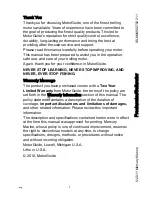
Installation and Operation
©
2009 Microchip Technology Inc.
DS51834A-page 17
2.6
SETTLING TIME, NOISE AND SAMPLING RATE
The bandwidth seen by the signal (DUT’s V
OST
and noise voltage), between the DUT’s
input and VM, is set mainly by the lowpass filter at the VM test point (TP5); this
bandwidth is about 1.6 Hz. This bandwidth sets the settling time seen at VM (after the
DUT’s bias point has been changed) to about 0.6 seconds.
The noise seen in the measurements is a result of DUT’s input noise voltage passed
through the same 1.6 Hz lowpass filter. The MCP651’s 1/f noise dominates at such low
frequencies, so V
OST
will appear to wander over time. The standard deviation of this
1/f wander can be estimated to be roughly:
• 5 µV
P-P
for a time period of 1 second
• 34 µV
P-P
for a time period of 10 years
Averaging several measurements together will help reduce the noise over a short
period of time. It must be understood, however, that the 1/f noise will make V
OST
appear to change over long periods of time.
There is a practical limit on increasing the sample rate; the noise does not improve
significantly after a certain point. The analog lowpass pole at 1.6 Hz causes closely
spaced samples to be correlated. To avoid the overhead caused by sampling too fast,
keep the sampling period near or above the pole’s time constant (0.10s); this gives a
minimum sample rate of 10 samples per second.
Note:
Sampling much faster than 10 SPS will not improve the averaged noise
significantly.
Содержание MCP651
Страница 1: ...2009 Microchip Technology Inc DS51834A MCP651 Input Offset Evaluation Board User s Guide...
Страница 22: ...MCP651 Input Offset Evaluation Board User s Guide DS51834A page 18 2009 Microchip Technology Inc NOTES...
Страница 28: ...MCP651 Input Offset Evaluation Board User s Guide DS51834A page 24 2009 Microchip Technology Inc NOTES...
















































